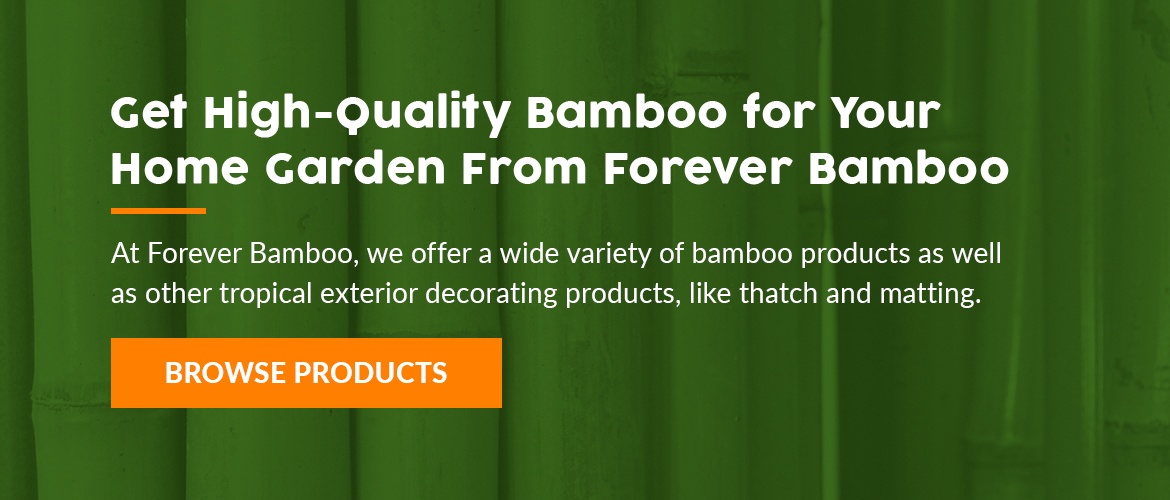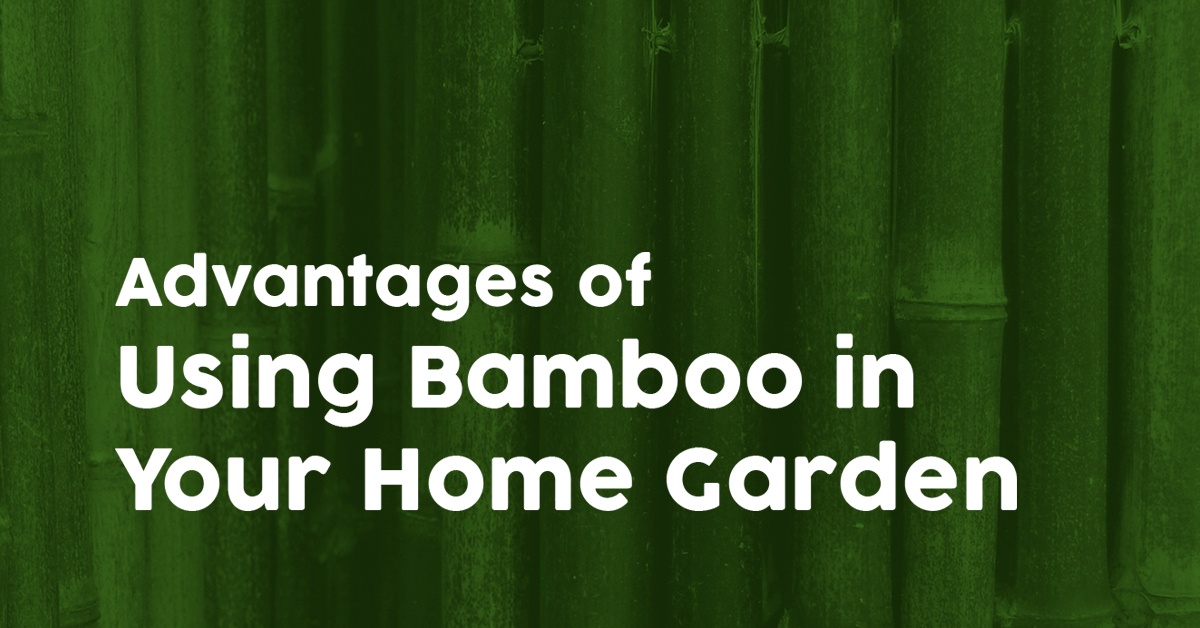
Whether you’re just starting to design your home garden or looking for something special to make your garden stand out, bamboo may be the answer. Whether it be a statement piece like a bamboo fence or the subtle addition of a bamboo hanging planter, this versatile material can take your home garden’s design to the next level.
The advantages of designing your home garden with bamboo products don’t stop at aesthetics. Bamboo is trendy, affordable, sustainable and eco-friendly, so it’s something you can feel good about adding to your garden. In this guide, we’ll discuss what the advantages of using bamboo products in your home garden are, how you can bring bamboo into your home garden design through easy DIY projects and what kind of bamboo to get started with.
Why Should You Use Bamboo?
Bamboo products, such as bamboo stakes, have a host of benefits that will help your garden’s aesthetic appeal and practicality. Gardening novices and experts alike choose outdoor bamboo products for their home gardens because bamboo is:
1. Practical for Planting
Depending on what types of crops you plan on growing in your garden, they will need support to prevent stems from snapping and fruit from drooping. Bamboo stakes are the perfect support for your plants because they’re sturdy, stylish and sustainable.
Bamboo is an incredibly hardy plant. Some species of bamboo even boast a tensile strength greater than that of steel, which means it is more than stable enough to keep your garden’s crops upright. By simply placing bamboo stakes around your plants in strategic areas, you can provide your plants the support they need to ensure a great harvest.
Bamboo is effective to use in your garden, and it’s easy to incorporate. The versatility and visually appealing aspects of bamboo make it the ideal gardening accessory. In addition to supporting your crops with bamboo, you can use it as a planter for smaller plants like flowers or even as decor.
Unlike other more cumbersome materials like hardwood, bamboo is relatively easy to cut and bend. Thanks to its pliable nature, bamboo can be used for various crafts and DIY projects to spruce up your garden design.
2. Decorative for Designing
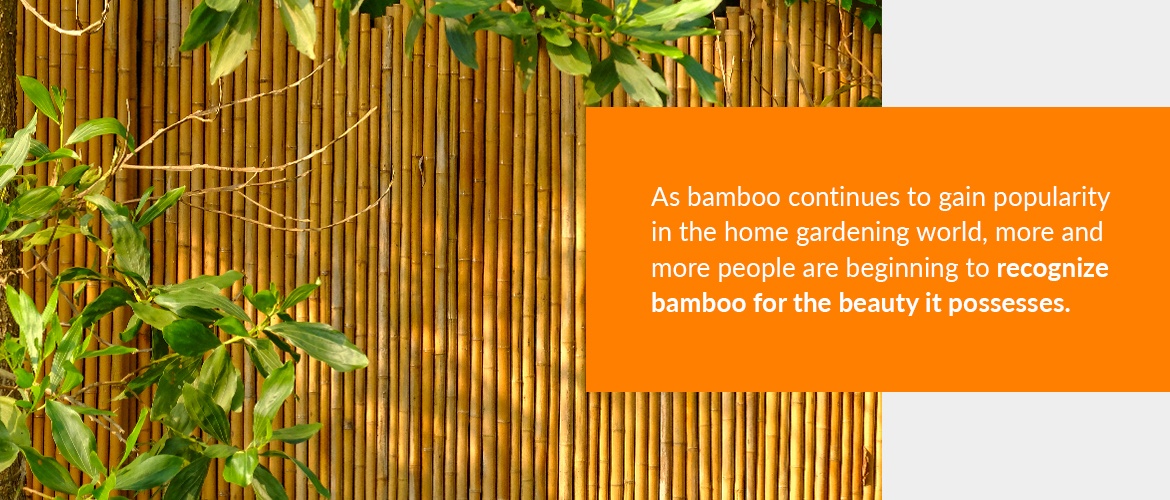
There are many visually attractive ways to include bamboo in your home garden. As bamboo continues to gain popularity in the home gardening world, more and more people are beginning to recognize bamboo for the beauty it possesses.
“Natural aesthetics” was named one of the top five home garden trends of 2020 by the Royal Horticulture Society, and one of the best ways to achieve that natural look is by incorporating bamboo products into your exterior design.
Many gardeners value bamboo for the natural aura it can bring to their garden designs. Because bamboo lends your home garden a natural, earthy quality, it creates a serene sanctuary no matter how close to the bustling city you live.
Bamboo can also be used to build a more tropical setting. If you’re trying to achieve a tropical atmosphere and make your home garden stand out, bamboo is your most valuable resource for tastefully adding an exotic flair.
3. Eco-Friendly for Earth
Using bamboo to craft a more visually appealing garden will benefit both your home garden and the planet. This is because bamboo is an eco-friendly and sustainable gardening option.
Bamboo absorbs more carbon dioxide and produces more oxygen than most plants. In fact, a grove of bamboo generates up to 35% more oxygen than a hardwood tree grove of the same size, while taking in four times as much carbon dioxide. A high carbon dioxide uptake helps slow global warming by clearing more carbon dioxide emitted by cars and factories from the atmosphere.
Bamboo’s powerful combination of oxygen production and carbon dioxide absorption abilities make it the perfect resource for the environmentally-conscious gardener.
Bamboo is known as a renewable resource that helps prevent deforestation because it grows rapidly when given the right conditions. In fact, bamboo can become fully mature in as little as seven years, which is an extremely short amount of time when compared to most types of trees. A plant’s rate of growth is important because it indicates how quickly the plant is able to replace forested areas.
While many other plants require the assistance of pesticides, herbicides or fertilizers to grow well, bamboo does not need any of these harsh and potentially harmful substances to flourish. Thanks to its additive-free and rapid growth rate, bamboo is an excellent alternative to traditional hardwoods. Considering all of the eco-friendly benefits it adds, from increasing oxygen to reducing deforestation, bamboo is one of the best products for designing a natural garden.
How to Use Bamboo Products in Your Garden
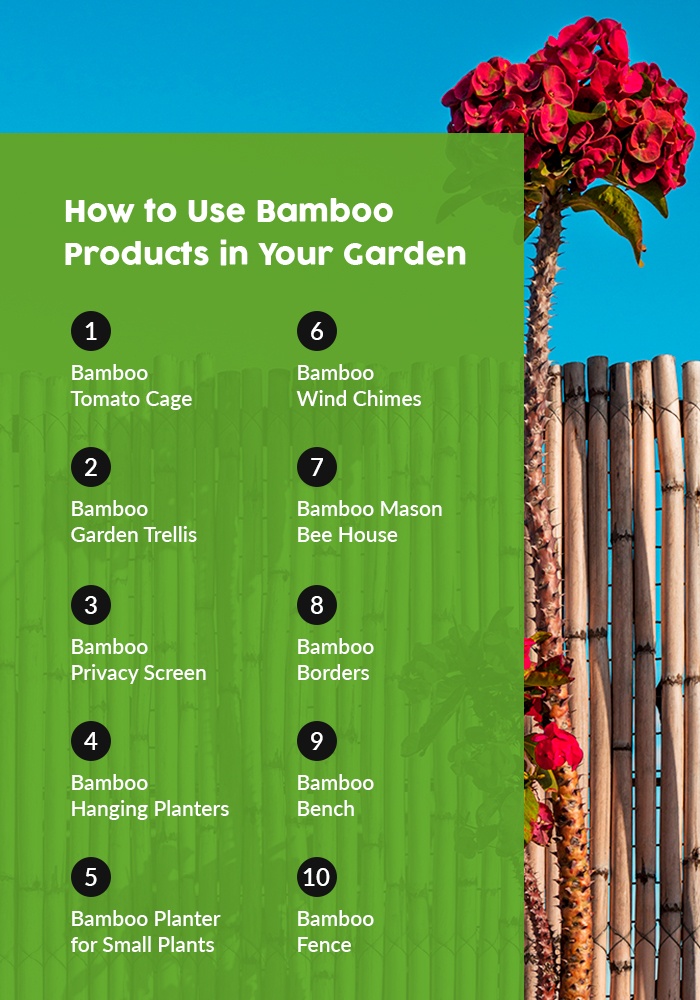
The number of ways that bamboo can be incorporated into your exterior decorating is nearly endless. From large structures like privacy screens and bamboo borders to smaller items like mason bee houses and wind chimes, bamboo can be used as the foundation of many home garden accent pieces.
Of course, you can always order already made and ready to use bamboo furniture to enhance the appeal of your garden’s design. But if you’re feeling crafty, there is a vast variety of DIY bamboo projects for your home garden that you can create with your own two hands. Here are just a few of those project ideas:
1. Bamboo Tomato Cage
Instead of using an unsightly wire cage, support your tomato plants in style by constructing a cage out of bamboo. Simply use bamboo poles and twine to build a sturdy structure around your tomato plant, then use smaller pieces of bamboo and twine to create tiers spaced sporadically up the cage’s frame to guide the plant’s growth vertically.
2. Bamboo Garden Trellis
Similar to the bamboo tomato cage, a bamboo garden trellis can be used to support other high-climbing plants like vine vegetables, pole beans, cucumbers or even some flowers. Once again, some bamboo and twine are all that’s needed to construct a basic A-shape trellis.
First, cut your bamboo poles to about the same length, then use twine to tie pairs or triads together. Place the untied ends in the soil and put crossbars across them as a separation barrier for your crops. Lastly, string the A-shaped frame with vertical twine climbers by tying the string at the bottom of one side, going over the top bamboo bar and tying the string on the bottom of the opposite side.
3. Bamboo Privacy Screen
To add a little privacy to your garden, first, have some thin wood pieces cut to the desired size of your privacy screen and secure the two outside pieces of the frame with L brackets. Then, add cup hooks to the top and bottom of the frame before positioning the bamboo fencing on them. Finally, close up the frame with the other two wood pieces and secure them with L brackets, as well.
4. Bamboo Hanging Planters
To make these savvy hanging planters, cut a piece of golden bamboo around a node, which will serve as the base of the planter, depending on how deep you want your planter to be. Next, drill holes for drainage and to string the wire that will hold the planters through. After that, add the wire and hang your new planter wherever you’d like.
5. Bamboo Planter for Small Plants
For an easy bamboo planter that holds smaller plants like succulents, create one out of a large half round bamboo pole. Drill a few drainage holes before filling the bamboo half with soil — and your planter is complete.
6. Bamboo Wind Chimes
Cut thin pieces of bamboo to a variety of lengths. Use hot glue to connect some of the pieces together to form a triangle, which will serve as the base of your wind chime. At the tops of your remaining bamboo pieces, glue wooden beads, so you can loop yarn through them to attach them to your triangular base. Loop additional long strands of yarn around the base, tying them in a tight knot at the top, so you can hang your wind chime from anywhere.
7. Bamboo Mason Bee House
Tying a bundle of bamboo reeds together and placing it in a tree is an easy and chic way to offer shelter to mason bees, a type of bee that doesn’t bite.
8. Bamboo Borders
Bamboo borders add an element of natural charm to your garden and require minimal effort on your part. Wrapping them around your plants in increasingly tighter circles to create a spiral garden is just one of many creative twists on the basic bamboo border.
9. Bamboo Bench
For the more advanced bamboo builder, a bamboo bench can be a nice addition to your home garden. Bamboo’s strength makes it a reliable material, and its pliability makes it simple to use.
Start by cutting large-diameter bamboo poles to form the bench’s legs. Then, make the bench’s sitting surface by connecting multiple bamboo poles together, either by tying them with twine or drilling holes for wire. Finally, drill holes, spaced vertically, in each of the four legs, and insert thinner bamboo poles into them in an X shape before securing with glue to give your bench cross support.
10. Bamboo Fence
Bamboo fences have become a home garden staple because they’re easy to install and far more attractive than regular wooden or chainlink fences. To make your own bamboo fence, purchase however many rolls of bamboo fencing you need, then use screws or zip ties to attach the bamboo fencing to your pre-existing fence. Don’t forget to form a barrier between your bamboo and the soil — try treated two-by-four boards — if the fence runs over your garden’s soil.
What Are the Best Bamboo Products for Your Garden?
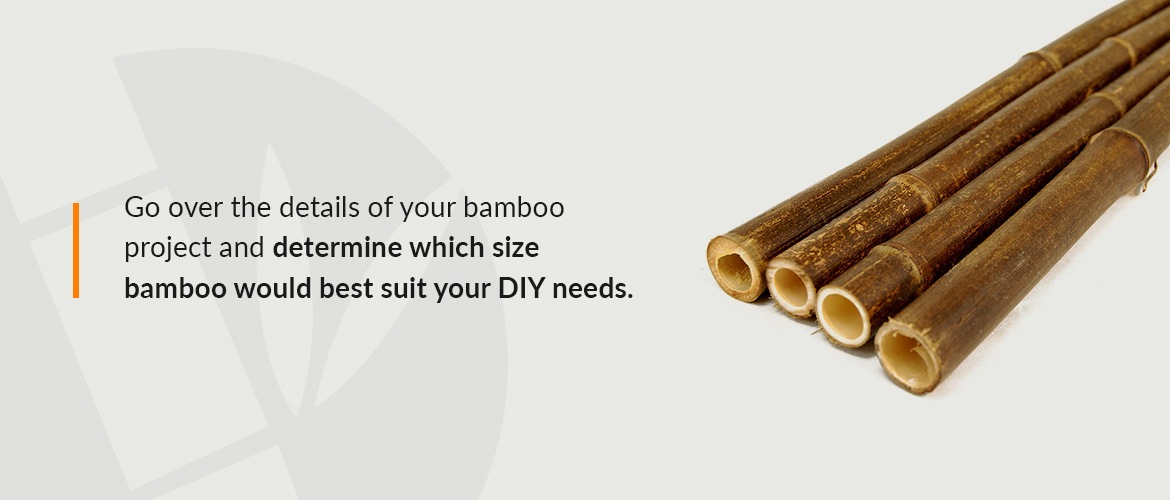
Now that you have some DIY ideas for how to use bamboo products in your garden, you will have a better idea of what type of bamboo to shop for. Go over the details of your bamboo project and determine which size bamboo would best suit your DIY needs. Then, you will be more prepared to explore your bamboo pole options.
Other than size, bamboo can differ in color and cut. Based on the design of your home garden, choose whether natural bamboo, which is the lighter tan color we traditionally associate with bamboo, or black bamboo would look fit best within your color scheme. Then, decide whether you should get your bamboo stalks pre-cut in half if your project is going to require you to use bamboo halves at some point.
Similarly, there are other decorative items, like fencing, that you can get ready-made to save yourself the trouble of stringing heavy bamboo stalks together yourself. Make sure you explore all the products available to you before wasting your time and energy struggling to construct something you could have easily bought.
Other aspects to keep in mind when choosing your type of bamboo is what kind of temperatures the bamboo will experience in your garden. Because bamboo can be found naturally across a wide range of climates, choose one that will do well in your area and be able to tolerate your lowest temperatures.
Bamboo stakes are the best type of plant stake for DIY crafters because they are easy to cut and manageable to work with. Bamboo stakes will save you from frustration and headaches, and they will do their job of supporting your plants as a resilient, durable plant that can thrive in several seasons and weather conditions. For those just venturing into the realm of exterior designing with bamboo, the many advantages of bamboo stakes make them a great way to begin your bamboo journey.
Bamboo Bonus Tips
Although bamboo is naturally an easy material to work with, here are a few extra pointers for how to build a garden with bamboo to ensure your DIY project goes smoothly:
- Staining: If you can’t find the exact shade of bamboo you want, you can customize your bamboo’s color by painting or staining it. It is suggested that you buy natural bamboo if you plan to customize it because the lighter color will show off the new color or stain better.
- Security: When securing bamboo pieces together, create a figure-eight pattern with the twine or string and then knot it tightly. If using screws, drill holes in the bamboo and then sink your screw instead of nailing directly into the bamboo.
- Safety: Always cut bamboo safely by using a fine-bladed hacksaw or a power saw. Using the right cutting tools will keep you from injury, and using the right saws and placing masking tape over the portion of bamboo you plan to cut will also prevent splintering and produce the cleanest cut possible.
Get High-Quality Bamboo for Your Home Garden From Forever Bamboo
To ensure you get high-quality bamboo for your home garden projects, order your bamboo from Forever Bamboo. At Forever Bamboo, we offer a wide variety of bamboo products as well as other tropical exterior decorating products, like thatch and matting. Although we are located in San Diego, CA, we ship our products internationally — with free shipping on many products.
Whether you’re still feeling uncertain about how to start implementing your bamboo home garden design or ready to jump in and start seeing the advantages of bamboo products, contact Forever Bamboo today.

